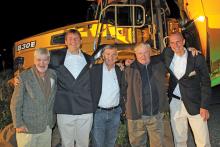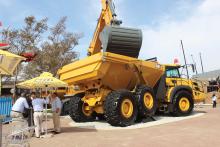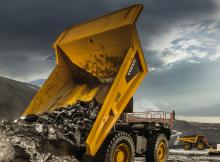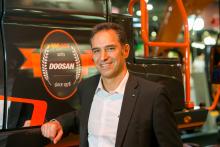Leon Goosen becomes Bell Equipment CEO on 1 June 2018, replacing the South African global articulated hauler truck giant’s longstanding CEO, Gary Bell, who is taking up the role of non-executive chairman of the company’s board. During the recent bauma CONEXPO AFRICA 2018 exhibition in Johannesburg, Guy Woodford talked to Goosen about how he intends to shape the next chapter of Bell Equipment’s impressive hauling legacy.
Leon Goosen grew up in his native Namibia surrounded by yellow iron. His father was a service technician who worked on the machine fleets of mining companies in his homeland, and the now 45-year-old Goosen remembers many a happy day in his youth spent examining trucks, loaders and other equipment.
Even after building a successful career as an audit partner with Deloitte & Touche (D&T), working out of the global sector giant’s Durban and Richards Bay offices in KwaZulu-Natal, South Africa, Goosen longed for the chance to work in the mining and quarrying machine industry. His big break came in 2007 while working out of D&T’s Richards Bay office on the accounts of
Noting what Goosen describes as his “absolute passion” for quarrying and mining equipment, and his admiration of the Bell brand, the previous chairman of Bell Equipment commercial, Howard Buttery, offered him a job, which he eagerly accepted.
Eleven years later, having worked as Bell Equipment’s chief operations officer and executive director, Goosen is about to take over as Bell Equipment CEO from Gary Bell, a son of one of the company’s founders.
“I have a very collaborative management style and have no plans to significantly shake-up the company,” stresses Goosen. “I want us to continue our growth path while staying true to our family roots and feel.”
Bell Equipment’s current eight 6x6 ADT model line-up offers payloads from 18-55tons: the B60E (55tonnes), B50E, B45E, B40E, B35E, B30E, B25E, and the B20E (low ground pressure 18ton model). All the company’s articulated dump trucks are said to be designed to give quarrying, mining and construction customers the lowest cost per ton.
For Southern Africa customers, Bell Equipment offers a comprehensive quarrying and mining fleet solution. The company is a partner dealer for
In the UK Bell Equipment also has a six-model 11-25ton class wheeled loader range, through a distribution arrangement with John Deere. It comprises the L1204E, L1506E, L1706E, L1806E, L2106E and L2606E.
Bell Equipment sells directly to customers in the Southern Africa and UK markets, and through dealers in the rest of the world. Goosen says there is a “continuous drive” to expand its global dealership network.
Keen to offer more ADTs specifically suited to quarry customers, Bell Equipment is introducing a global range of 4x4 articulated dump trucks. The new 4x4 range will, says Goosen, offer lower running costs, more manoeuvrability via a smaller turning circle and extra safety through added tyre traction in quarry-based applications. The first of the new 4x4 models – a 30ton class – will be launched at INTERMAT 2018 in Paris. Two other 4x4 models will follow before the end of 2018, with more coming in 2019.
“There are many quarries globally that are not mega-sized quarries and see 30ton class ADTs as perfect for them, but they also want that 4x4 ground contact and handling,” emphasises Goosen.
Bell Equipment already has a successful history of manufacturing 4x4 ADTs, with such models having been built by the firm in the early 1990s for mainly South African market customers.
Bell Equipment is also keen to introduce a 12ton class ADT within the next two years. Goosen says this will be in response to customers increasingly asking for smaller, more mobile and easy-to-drive articulated trucks for their work sites.
Around 30% of Bell Equipment model sales are in North America – with the USA traditionally being the world’s biggest national market for ADTs; 30% of sales are in Europe; and 30% of sales are in Africa and the East. The rest of the world makes up the remaining 10% of global sales.
Bell Equipment only re-entered the American markets in 2013 and their continual growth, according to Goosen, is due to customers wanting to deal with a specialist ADT brand. Bell Equipment’s performance in North America is particularly impressive given that it grew its sales despite overall ADT sales in North America falling every month from the beginning of 2016 till late in 2017.
Goosen says that as North America has been a huge growth area for Bell Equipment, the firm is opening a new logistics centre in Charlotte, North Carolina, before the end of this year. Goosen says the location was chosen as its logistics are good and it is “quite central in terms of the eastern seaboard”, where the “majority of [USA] ADTs get sold”.
South East Asia is said by Goosen to offer big sales growth potential, through countries including Indonesia, Vietnam, Cambodia, Philippines and Laos. He says he’s been to Indonesia and seen first-hand the huge demand for quality ADTs, with the majority of applications and conditions beset by heavy rainfall ideally suited to articulated dump truck use. Looking at the company’s native South Africa, Goosen says the past year has seen renewed confidence in the market – partly due to the installation of new president Cyril Ramaphosa. He says customers who had delayed buying new equipment are starting to invest again.
Goosen says that Zimbabwe has been a “success story” since Robert Mugabe finally stepped down as the country’s controversial president, and the appointment of his successor, Emmerson Mnangagwa. He says there remains “significant pent-up demand” for new yellow iron.
Goosen feels it’s a question of “when” not “if” African countries invest heavily in equipment in order to meet their huge demand for new transport infrastructure and residential and commercial buildings. He believes stable and good governance can help in this regard.
Of Europe, Goosen says there is still good demand for its ADTs. Germany is a strong market for Bell Equipment, and Britain is good, with major infrastructure projects like Hinckley Point nuclear power station and High Speed 2 (HS2) requiring a lot of dump trucks and other construction and quarrying equipment. The B20E is said by Goosen to be a popular model in the UK. France is also another traditionally strong ADT market that continues to be attractive to Bell Equipment. Russia is a further European market that has seen a “bit of growth”, according to Goosen.
Bell Equipment is spending US$12.35 million (€10mn) expanding its assembly plant in Eisenach, central Germany. Part of the investment will enable onsite fabrication work on the company’s ADTs. The Eisenach site supplies ADTs directly to northern hemisphere markets, ensuring more flexibility and a greatly reduced lead time than would be possible if the trucks were shipped from South Africa.
“If you are a global manufacturer, you need to make sure that you manufacture as close to your customer markets. It’s common sense and ensures efficiencies,” emphasises Goosen. “Internally, too, we want to use our three hubs, in South Africa, Europe and the US, to get our logistics more efficient, and to consolidate more on the components that we are buying through the use of SAP (business resource planning software).
“You can’t realistically stock a part in every location, but you need to work out how you can get a customer a part as quickly as possible. It’s all about investing in customer support. Customers used to order a part and get it later in the week. Now they want it tomorrow morning!”
Bell Equipment, whose global revenues rose from R6 billion (US$510.09mn) in 2016 to R6.8 billion ($578.11mn) last year, has also tripled in recent years its investment in training and support for its global network of engineers and dealers, with current worldwide [parts] inventory setting a new company record. As well as putting more engineers out in the field, closer to customers, Bell Equipment is also making sure that they are only working with the highest quality tools to enable them to work with optimum efficiency. “It’s all about more people touching the product, more of our people spending time with customers,” says Goosen.
In 10 years’ time, Goosen wants Bell Equipment to be seen globally as the premier articulated dump truck manufacturer. “We have the world’s best articulated haul trucks. Let’s show the world what they can do!”
Such obvious passion for Bell Equipment, the company’s expanding machine range and the quarrying and mining markets as a whole leaves you with the impression that accountancy’s loss is very much our global industry’s gain.













